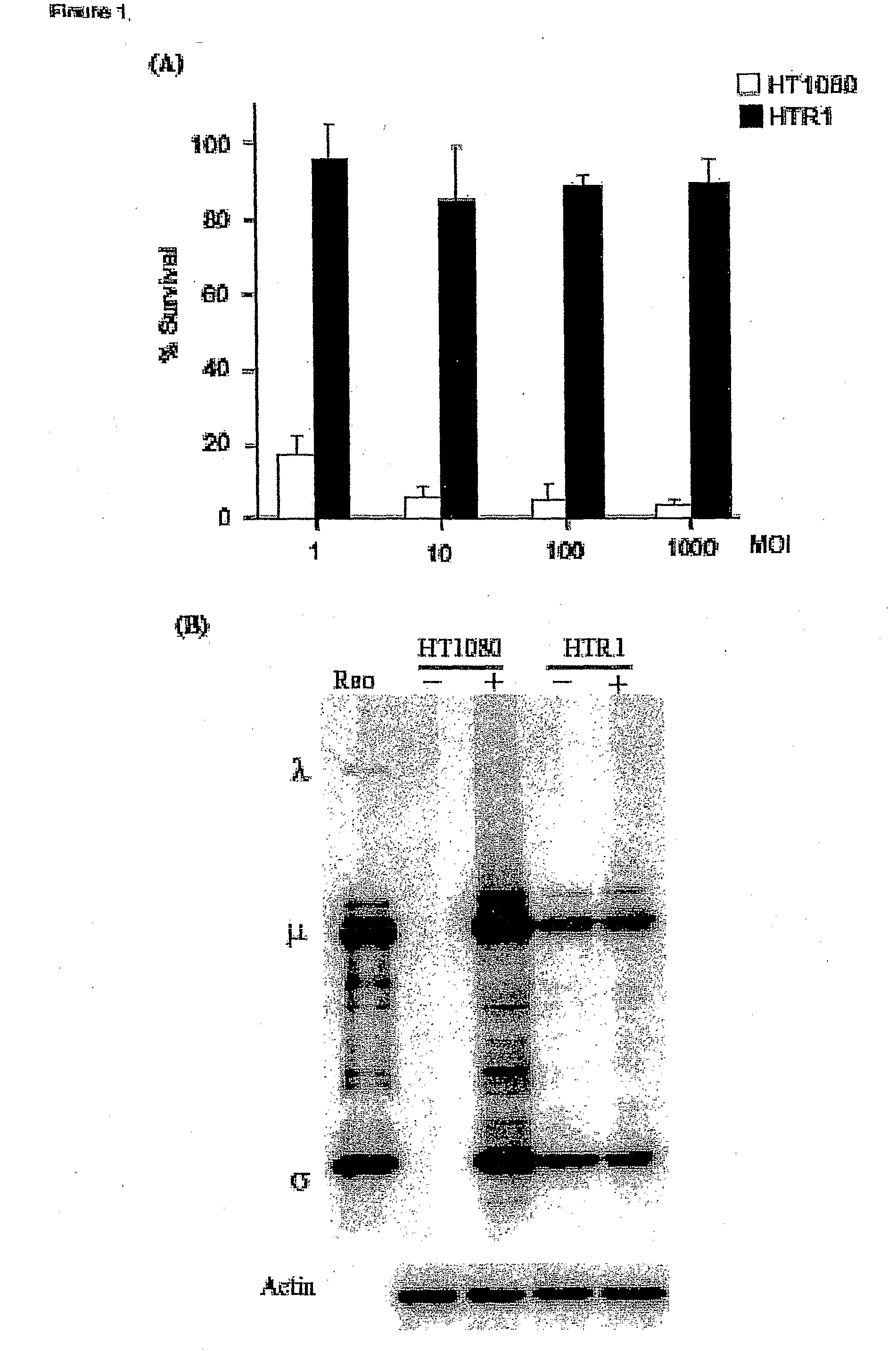Attenuated reovirus
a reovirus and attenuation technology, applied in the field of viruses, can solve the problems of compromising the integrity of the host stem cell compartment, unable to achieve optimal effect, and the treatment of oncolytic reoviral treatments may not achieve the effect of ideal effect, and achieve the effect of reducing the level of at leas
- Summary
- Abstract
- Description
- Claims
- Application Information
AI Technical Summary
Benefits of technology
Problems solved by technology
Method used
Image
Examples
example 1
Generation of Attentuated Reovirus By Persistent Human Reovirus Infection of a Cell Line
[0087]A. Materials & Methods
[0088]Standard laboratory procedures were adopted from Ausubel et al. (1989); Ausubel et al. (1993); Sambrook et al. (1989); Maniatis et al. (1982); Glover, 1985); Hames and Higgins (1985). All reagents were from Sigma-Aldrich (St. Louis, Mo.) unless otherwise noted.
[0089]Cell lines and viruses. Human fibrosarcoma (HT1080), normal primary human foreskin fibroblast (Hs68), HeLa, murine L929 and human 293 cell lines were purchased from the American Type Culture Collection (ATCC, Manassas, Va.). The cells were maintained according to ATCC protocols. The resistant cell line (HTR1) derived from HT1080 cells was maintained for more than 36 months. The Dearing strain of reovirus serotype 3 used in these studies was propagated in suspension cultures of L929 cells and purified according to Smith et al. (1969) with the exception that β-mercaptoethanol was omitted from the extrac...
example 2
Characterization of Attenuated Reovirus
[0108]Reovirus generated from the HTR1 cells as described in Example 1 was assessed for cytopathic activity toward parental HT1080 cells by exposing parental cells to supernatant medium prepared from cultured HTR1 cells. Significant cell death and viral protein synthesis were observed (FIGS. 4B, 4C), indicating that the reovirus generated from the resistant culture (HTR1) was still functional. Reovirus prepared from the resistant culture, designated as AV (Adapted Virus), showed differential apoptosis-inducing activity compared to the original laboratory strain wild-type reovirus. The AV virus showed significant cytopathic and apoptotic activity only with the parental HT1080 cells, but not with 293 cells or L929 cells (FIGS. 4A, 4B). Because the sigma 1 (σ1) protein of reovirus had demonstrated importance in reovirus-mediated apoptosis (Connolly et al., 2001), the S1 gene segment of the AV virus was sequenced and found to contain several mutati...
example 3
In Vivo Tumorigenicity of HTR1Cells Persistently Infected with an Attenuated Reovirus
[0112]Materials and Methods were as described above in Example 1, with the addition of the following protocol for determining in vivo tumorigenicity of HTR1 cells, which produce AV, an exemplary attenuated reovirus: 5×106 cells of HT1080, HTR1, Cured (Dermody et al., 1995; Ahmed et al., 1981) and a mixture of HTR1 and Cured cells were suspended in 100 μl of PBS and injected into the left flanks of 6 to 8 week-old severe combined immunodeficient (SCID) mice (Charles River, Wilmington, Mass.). Mice were treated according to protocols approved by the University of Calgary Animal Care Committee. Tumor growth was monitored by weekly measurement. Mice were sacrificed when they had black tails caused by unconstrained reovirus-mediated pathology (Loken et al., 2004), or difficulty due to tumor burden. Tumors were fixed in 4% paraformaldehyde at room temperature, and tumor specimens were sent to the Universi...
PUM
| Property | Measurement | Unit |
|---|---|---|
| diameter | aaaaa | aaaaa |
| temperature | aaaaa | aaaaa |
| pH | aaaaa | aaaaa |
Abstract
Description
Claims
Application Information
 Login to View More
Login to View More - R&D
- Intellectual Property
- Life Sciences
- Materials
- Tech Scout
- Unparalleled Data Quality
- Higher Quality Content
- 60% Fewer Hallucinations
Browse by: Latest US Patents, China's latest patents, Technical Efficacy Thesaurus, Application Domain, Technology Topic, Popular Technical Reports.
© 2025 PatSnap. All rights reserved.Legal|Privacy policy|Modern Slavery Act Transparency Statement|Sitemap|About US| Contact US: help@patsnap.com



